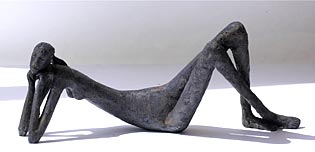The Not-So-Lost Art of Lost Wax Casting

Bronze sculpture created using the lost wax casting
Photograph by Rowan Gillespie
The casting itself is an involved process that varies with different foundries, but all pieces start with a sculptor or artist who create original artwork from wax or oil-based clay. Both of these substances retain their softness.
A two-piece mold is created from the original sculpture and within that mold is an inner mold of latex, vinyl or silicone supported by the plaster part of the mold. The original artwork is destroyed during the making and initial deconstruction of the plaster mold because the originals are usually solid and not easily bent when the plaster mold is removed. Once this process is finished, molten wax is poured onto it for an even coating until the correct thickness has been reached, and it's at that point that the hollow wax copy of the artwork is removed. The hollow wax copy is then 'chased' using a hot metal tool that rubs out the parting line marks where the mold comes together. Next, the wax is 'dressed' to hide imperfections, and at this point, the wax appears as finished bronze.
But, that's not all. Other steps include spruing, a process that provides room for molten bronze to flow and air to escape, then slurrying, where the sprued wax copy is dipped into a 'slurry' of liquid silica, and then a sand-like stucco, or dry crystalline silica of a controlled grain size. A ceramic shell coated piece is placed in a kiln where melted wax can be recovered and reused. The process after that includes testing, pouring, release, metal-chasing, and patinating until the bronze is created to the artist's liking.
David Carradine, who demonstrated his work on the popular Do-It-Yourself Network, first began sculpting after his parents took him to see Fantasia.
"I got the book, sculpted all the dinosaurs in clay, and put them on the windowsill in descending order of size---up to the Tyrannosaurus Rex," he explains. "When I was a child, I sculpted a lot and always had a ball of plastaline. In school, I'd make stuff instead of taking notes and always had a piece of clay in my pocket."
Carradine's great uncle, Will Foster, was known for his paintings and Carradine studied with him as a kid, when he could, then studied music formally at the San Francisco State College of Theory and Composition. His goal in life at that time was to write operas.
"I think anybody that has a creative drive could go any one of these ways," he explains. "You (take a) look at contemporary art and it's all inspiration. I actually sold some paintings for $50 each when I was 22 or 23, and color-coded them to people's houses. But, I didn't care for that. I had a little house in the Hollywood Hills full of my work, but one day I just decided that I'm getting out of here."
Three decades later, Carradine is still a busy actor as well as a talented musician, painter and sculpture. His life still embodies the mysticism of the East in many ways, like Kane, his character in Kung Fu.
"Regarding my passion for sculpting, I want to examine the fabric of the universe, to understand it better," he says. "And, you can do it with your hands."
Also in this Issue:
- Public Sculpture Series Bronzes Notable TV Icons
- Yoshitomo Saito: The Bronze Weaver
- The Patriotic Roots of Valley Bronze of Oregon
- The Not-So-Lost Art of Lost Wax Casting
- Stellar Collection of Renaissance Sculpture Promised to National Gallery of Art by Robert H. Smith
